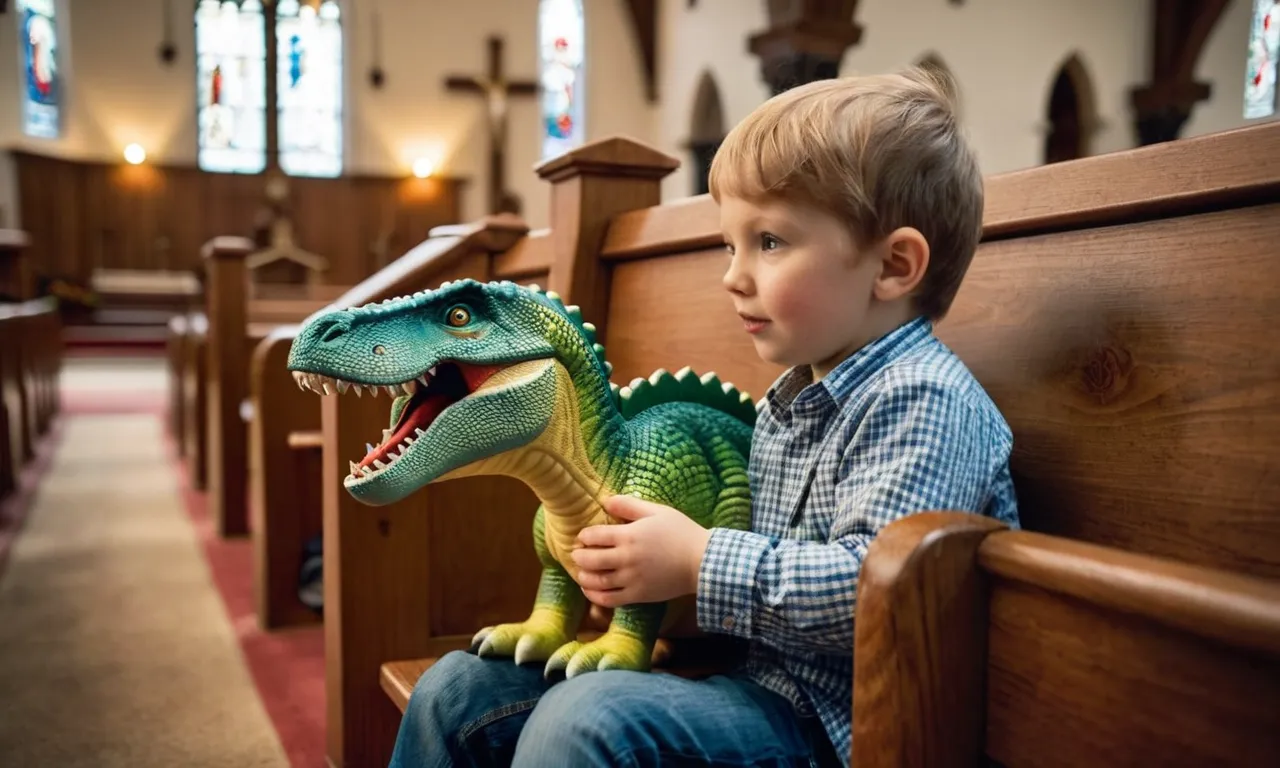What Does Christianity Say About Dinosaurs?
Dinosaurs have fascinated people for centuries, but where do they fit in with Christian beliefs? As creatures that lived long before humans, dinosaurs present an intriguing challenge to the traditional reading of Genesis.
This article will dive into what the Bible and Christian scholars have to say about these prehistoric beasts.
If you’re short on time, here’s a quick answer to your question: While the Bible does not directly mention dinosaurs, most Christians believe that God created the dinosaurs along with the rest of the animals and that they lived on Earth long before humans arrived on the scene.
Dinosaurs Are NotMentioned in the Bible
The Bible does not directly mention the existence of dinosaurs or other prehistoric creatures. This is because the term “dinosaur” was not even coined until 1842 by the British scientist Sir Richard Owen. Before that, these creatures were not recognized as a separate group.
However, some Bible passages have been interpreted by some as possible references to dinosaur-like creatures.
The term “dinosaur” was not coined until 1842
Dinosaurs as a group were not recognized or categorized until the 19th century. The word “dinosaur”, meaning “terrible lizard”, was coined by the British scientist Sir Richard Owen in 1842 to refer to the large fossilized reptiles which were just beginning to be discovered at that time.
So naturally, a term not invented until the 1800s would not appear in ancient Biblical texts. Earlier translations of the Bible into English used the word “dragon” for large reptilian creatures. But scholars agree these were likely referring to serpents or giant marine creatures, not what we would call dinosaurs today.
Possible references to dinosaur-like creatures
Some passages in the Bible have been interpreted by some as possible vague references to large reptilian creatures. For example:
- Job 40 discusses “behemoth” which has been claimed to describe a sauropod dinosaur.
- Isaiah 27:1 mentions “Leviathan” which some claim refers to a dinosaur.
- The numerous references to “dragons” in the King James Version could imply dinosaur-like creatures.
However, most Bible scholars believe these terms were intended to refer to other creatures alive at that time, such as elephants, hippos, serpents, or crocodiles – not extinct dinosaurs.
| Term | Common interpretations |
|---|---|
| Behemoth | A hippopotamus or elephant |
| Leviathan | A whale, giant serpent, or crocodile |
| Dragon | A giant serpent or marine reptile |
So while these texts may allude to large and fantastic creatures, there is no scholarly consensus they are definitively referring to extinct dinosaurs.
Interpretations of Genesis allow for an old Earth
According to most scientists, dinosaurs went extinct around 65 million years ago, while modern humans evolved much more recently. So if dinosaurs existed millions of years before humans, why doesn’t the Bible mention them? There are a few possible explanations:
- Not all Christians interpret the Genesis account of creation to mean the Earth is only 6,000-10,000 years old. Many accept the scientific evidence of an older Earth of over 4 billion years old, with room for evolution and extinction of species like dinosaurs.
- If the “days” of creation in Genesis are taken to represent long periods of time, there would be ample time for species like dinosaurs to exist before humans.
- Dinosaurs may simply not have been relevant details for the Bible’s spiritual narratives focused on human interactions with God.
Most Christian theology focuses on spiritual truths about God, human nature, and ethics – not details of natural history. So the Bible’s silence on dinosaurs and other prehistoric life does not necessarily contradict modern science or its own credibility.
Christian Views on When Dinosaurs Lived
Young Earth Creationism – dinosaurs lived alongside humans
The belief of Young Earth Creationists is that God created the universe, earth, all life on earth including dinosaurs, and the first two human beings—Adam and Eve—just 6,000 to 10,000 years ago. They reject the scientific evidence for the great antiquity of the earth and universe.
According to this view, dinosaurs and humans must have lived at the same time not that long ago, between 6,000 to 10,000 years in the past. Most Young Earth Creationists believe dinosaurs were passengers on Noah’s Ark and became extinct sometime after the great flood described in Genesis.
Old Earth Creationism – dinosaurs lived before modern humans
Old Earth Creationists accept the scientific evidence that the earth and universe are billions of years old. Unlike Young Earth Creationists, they do not hold a strictly literal view of the Genesis creation narrative.
Old Earth Creationists typically believe that God created different life forms progressively throughout earth’s history over billions of years. They believe that dinosaurs were created long before humans—sometimes separated by tens or hundreds of millions of years—and became extinct long before modern humans evolved.
Theistic evolution – dinosaurs evolved long before humans
Theistic evolution is the view that evolution occurred as scientists describe it, but that God set this process in motion and guided it over billions of years. Theistic evolutionists fully accept the common ancestry of life on earth and the great antiquity of the universe.
According to the theistic evolution view, dinosaurs evolved through natural processes hundreds of millions of years ago, long before humans evolved. While God initiated and oversees the evolutionary process, theistic evolution does not typically involve miraculous divine interventions in the process at different points in time.
A 2022 Pew Research survey found that of practicing Christians in the U.S.:
- 47% believe humans evolved over time, guided by God
- 40% believe humans were created within the last 10,000 years
- 13% believe humans evolved without God’s involvement
While opinions vary widely, most Christians acknowledge through their beliefs about dinosaurs and humans that a great span of time passed between when dinosaurs walked the earth and when the first modern humans appeared.
What Caused the Extinction of the Dinosaurs?
Possibility of a world-wide flood
One theory for the extinction of the dinosaurs is the possibility of a world-wide flood, as described in the Bible. This catastrophic flood could have wiped out many land-dwelling species like the dinosaurs.
According to the book of Genesis, God caused a great flood to cover the entire earth for 40 days and 40 nights. This flooded the earth’s landmasses and caused massive destruction. While some scholars debate whether the flood was geographically universal or localized, a devastating regional or global flood could explain the sudden disappearance of dinosaurs from the fossil record.
Proponents of this theory point to geological evidence of large-scale flooding in earth’s history and fossils of sea creatures found on mountaintops as support. Of course, it’s difficult to prove conclusively that a biblical-scale flood caused the demise of the dinosaurs.
But the possibility of major flooding on a global or regional scale remains plausible. This cataclysmic event could have led to ecosystem collapse, catastrophic climate change, and the inability of giant creatures like sauropods and theropods to survive the new environmental conditions.
So while debated, the Great Flood provides one potential explanation for the abrupt extinction of dinosaurs worldwide.
Asteroid impact theory
The leading scientific theory for the extinction of the dinosaurs is the asteroid impact theory. Around 66 million years ago, a massive asteroid estimated to be 6 miles (10 km) wide crashed into the Gulf of Mexico.
This triggered catastrophic climate changes and habitat destruction that led to the extinction of all dinosaur species (except some bird lineage dinosaurs) along with 75% of plant and animal species on earth.
This asteroid impact would have blocked sunlight causing global cooling, sparked widespread wildfires polluting the atmosphere, and brought acid rain destroying plant life that dinosaurs depended on for food. It also caused massive tsunamis and earthquakes contributing to environmental devastation.
The Chicxulub crater found under the Yucatán Peninsula provides strong evidence that an asteroid struck here and caused the Cretaceous–Paleogene (K–Pg) extinction event wiping out the dinosaurs.
While other factors like volcanic eruptions may have stressed dinosaur populations, the asteroid impact is the predominant theory for their final extinction. The rapid climate changes and habitat destruction from the crash would have made it impossible for giant dinosaurs to adapt and survive, driving them to complete annihilation.
This asteroid impact theory explains both the abruptness and totality of dinosaur extinction at the end of the Cretaceous period.
Other extinction theories
Some other theories proposed for the extinction of dinosaurs include:
- Gradual climate change – Potential global cooling along with drying environments made it harder for dinosaurs to survive.
- Disease – Deadly epidemics could have rapidly spread through dinosaur populations.
- Vulcanism – Increased volcanic activity could have caused habitat loss and atmospheric changes.
- Competition with mammals – As mammals diversified, they may have outcompeted dinosaurs.
- Loss of plant diversity – Reduced plant biodiversity decreased dinosaurs’ food sources.
While these theories may explain stresses on dinosaur populations, most scientists agree they were likely secondary factors. The massive and abrupt extinction of all dinosaurs is best explained by the asteroid impact theory.
However, questions still remain about why dinsoaurs went extinct while some other species survived. Continued research on climate data, fossil records, and extinction events is needed to fully solve the mystery of dinosaurs’ disappearance.
Ultimately, dinosaurs dominated the earth for over 160 million years until a sudden catastrophic event – likely a devastating asteroid strike – led to their complete downfall. This extinction event ended the age of dinosaurs but opened new evolutionary opportunities for mammals and eventually humans to arise.
What Can Dinosaurs Teach Us About God?
Dinosaurs display God’s creative power
The enormous size and intriguing features of dinosaurs showcase the creative capacity of God. Sauropods like Argentinosaurus stretched over 120 feet long and weighed over 70 tons, demonstrating the vast diversity of life forms God can design (1).
The plates and spikes of Stegosaurus, the horns and frill of Triceratops, the sailback of Spinosaurus – these unique structures reveal the ingenious ways God equips His creatures. Dinosaurs prompt awe at the power of the Creator to invent body plans far beyond what we see today.
Fossils test but do not contradict faith
While evolutionary scientists view dinosaurs as evidence of an old earth and macroevolution, Christians need not feel challenged. The Bible does not provide all the details on timeframes and methods of creation.
As Augustine said, biblical texts should not be interpreted literally if science demonstrates physical impossibilities. Rather than contradicting faith, dinosaurs can strengthen our wonder at God’s creative glory.
Fossils only reveal traces of bones, and deducing ages and lineages involves major assumptions. As more dinosaur soft tissues are discovered intact (2), the evolutionary timeline grows more questionable.
Christians should feel free to question secular views requiring millions of years for dinosaurs to evolve and go extinct. An open-minded, careful look at the evidence can reinforce faith rather than undermining it.
Dinosaurs prompt us to praise God’s design
From Job to Psalms, Scripture urges us to meditate on animals and birds to heighten our awe of the Maker. Many dinosaurs were stunningly suited to their environments – we should praise the Lord for every species. Sauropods with bird-style respiratory systems thrived at giant sizes (3).
Spinosaurus was a super predator of river systems. Herbivores like Stegosaurus and Triceratops boasted elaborate defensive armor. Examining these long-lost creatures moves us to worship the God who crafted them all.
We may never fully understand dinosaurs this side of eternity. But we can stand in awe of the One who made leviathans and lunged life in all its diversity. Dinosaurs display the extravagant creativity of the Lord.
May these vanished creatures turn our eyes to the everlasting God who set their glory in the land of the living (Job 12:7-10).
Conclusion
In the end, while the Bible does not directly address the existence of dinosaurs, Christians have developed several views on how to understand dinosaurs within the context of their faith. Studying dinosaurs can still help us appreciate the grandeur and intricacy of God’s creation.
Although questions remain, Christians believe that all truth ultimately points back to the God who created everything.








